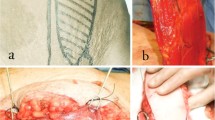Abstract
Background
The rectus abdominis myocutaneous (RAM) flap is one of the most commonly used flaps in reconstructive surgery, and many designs have been published. The transverse rectus abdominis myocutaneous (TRAM), vertical rectus abdominis myocutaneous (VRAM), and oblique designs (ORAM) are the most common. The most frequent complication with these flaps is partial flap necrosis. We describe a new vascular zoning method and a revised classification of abdominal wall perfusion that is applicable when harvesting pedicled TRAM flaps to make them more secure.
Methods
From February 2009 to February 2013, we performed 70 pedicled RAM flaps in 68 patients for breast reconstruction (79 %) as well as pelvic and inguinal reconstruction after bowel and gynecologic tumor resection. Clinical data about cutaneous vascularization of the flaps along with before and after photos were prospectively collected and analyzed, and results were evaluated retrospectively. We collected observations on partial flap necrosis, reviewed the literature, and made design modifications to exclude doubtful vascular territories.
Results
Of the total number of flaps, 59 were TRAMs, 7 were VRAMs, and 1 was an ORAM flap. Three combined horizontal and vertical flaps, or what we call TV RAM flaps, were performed. No flap-related complications were observed with VRAM, TV RAM, or ORAM flaps. Three instances of partial necrosis (in the same vascular territory) occurred with TRAM flaps; as a result, we changed our approach to these flaps and examined alternatives to the classical vascular zoning.
Conclusion
We discussed abdominal skin perfusion in accordance with the literature and based on our experience with harvesting pedicled RAM flaps. We proposed safer skin paddles made possible by adopting a revised vascular classification.
Level of Evidence V
This journal requires that authors assign a level of evidence to each article. For a full description of these Evidence-Based Medicine ratings, please refer to the Table of Contents or the online Instructions to Authors www.springer.com/00266.












Similar content being viewed by others
References
Holmström H (1979) The free abdominoplasty flap and its use in breast reconstruction. An experimental study and clinical case report. Scand J Plast Reconstr Surg 13(3):423–427
Hartrampf CR, Scheflan N, Black PM (1982) Breast reconstruction with transverse abdominal island flap. Plast Reconstruct Surg 69:216–225
Taylor GI, Corlett R, Boyd JB (1983) The extended deep inferior epigastric flap: a clinical technique. Plast Reconstr Surg 72:165–751
Salmon M (1936) Artères de la peau. Masson, Paris
Taylor GI, Palmer JH (1987) The vascular territories (angiosomes) of the body: experimental study and clinical applications. Br J Plast Surg 40:113–141
Saint-Cyr M, Wong C, Schaverien M, Mojallal A, Rohrich RJ (2009) The perforasome theory: vascular anatomy and clinical implications. Plast Reconstr Surg 124(5):1529–1544
Hamza F, Yousif J, Kotti B (2010) Breast reconstruction using the free TRAM flap in a private practice setting. A review of 20 cases. Ann Chir Plast Esthet 55(6):524–530
Staiano JJ, Wong L, Butler J, Searle AE, Barton DP, Harris PA (2009) Flap reconstruction following gynaecological tumour resection for advanced and recurrent disease–a 12 year experience. J Plast Reconstr Aesthet Surg 62(3):346–351
Soper JT, Secord AA, Havrilesky LJ, Berchuck A, Clarke-Pearson DL (2005) Rectus abdominis myocutaneous and myoperitoneal flaps for neovaginal reconstruction after radical pelvic surgery: comparison of flap-related morbidity. Gynecol Oncol 97(2):596–601
John HE, Jessop ZM, Di Candia M, Simcock J, Durrani AJ, Malata CM (2013) An algorithmic approach to perineal reconstruction after cancer resection–experience from two international centers. Ann Plast Surg 71(1):96–102
Mathes SJ, Nahai F (1981) Classification of the vascular anatomy of muscles: experimental and clinical correlation. Plast Reconstr Surg 67(2):177–187
Boyd JB, Taylor GI, Corlett R (1984) The vascular territories of the superior epigastric and the deep inferior epigastric systems. Plast Reconstr Surg 73:1–4
Buck DW 2nd, Fine NA (2009) The pedicled transverse rectus abdominis myocutaneous flap: indications, techniques, and outcomes. Plast Reconstr Surg 124(4):1047–1054
Moon HK, Taylor GI (1988) The vascular anatomy of rectus abdominis musculocutaneous flaps based on the deep superior epigastric system. Plast Reconstr Surg 82:815–832
Hartrampf CR (1984) Transverse abdominal island flap technique. University Park Press, Baltimore
Alvi R, Falder S, McGeorge DD (2002) A simple modification of TRAM flap breast reconstruction. Br J Plast Surg 55(2):173
Scheflan M, Dinner MI (1983) The transverse abdominal island flap: part I. Indications, contraindications, results, and complications. Ann Plast Surg 10:24–35
Scheflan M, Dinner MI (1983) The transverse abdominal island flap: part II. Surgical technique. Ann Plast Surg 10:120–129
Dinner MI, Dowden RV, Scheflan M (1983) Refinements in the use of the transverse abdominal island flap for postmastectomy reconstruction. Ann Plast Surg 11:362–372
Masson J, Staub G, Binder JP, Martinaud C, Couturaud B, Revol M, Servant JM (2007) Reconstruction mammaire. Techniques et indications. Elsevier Masson, Paris, pp 45–665. doi:10.1016/S1286-9325(07)47005-4
Taylor GI, Corlett RJ, Dhar SC, Ashton MW (2011) The anatomical (angiosome) and clinical territories of cutaneous perforating arteries: development of the concept and designing safe flaps. Plast Reconstr Surg 127(4):1447–1459
Rickard R (2001) TRAM and DIEP flap zones. Br J Plast Surg 54(3):272–273
Quilichini J, Le Masurier P, Guihard T (2010) Increasing the reliability of SIEA flap using peroperative fluorescent angiography with indocyanine green in breast reconstruction. Ann Chir Plast Esthet 55(6):531–538
Acknowledgments
I thank Dr. Jaidane for her diligent assistance. Thanks to Dr. Bechouche and many thanks to the Salah Azaiz Surgery team for their hard work and excellent performance every day, sometimes under difficult conditions.
Conflict of interest
The author declares that he has no conflicts of interest to disclose.
Author information
Authors and Affiliations
Corresponding author
Rights and permissions
About this article
Cite this article
Kotti, B. Optimizing the Pedicled Rectus Abdominis Flap: Revised Designs and Vascular Classification for Safer Procedures. Aesth Plast Surg 38, 387–394 (2014). https://doi.org/10.1007/s00266-014-0273-y
Received:
Accepted:
Published:
Issue Date:
DOI: https://doi.org/10.1007/s00266-014-0273-y




